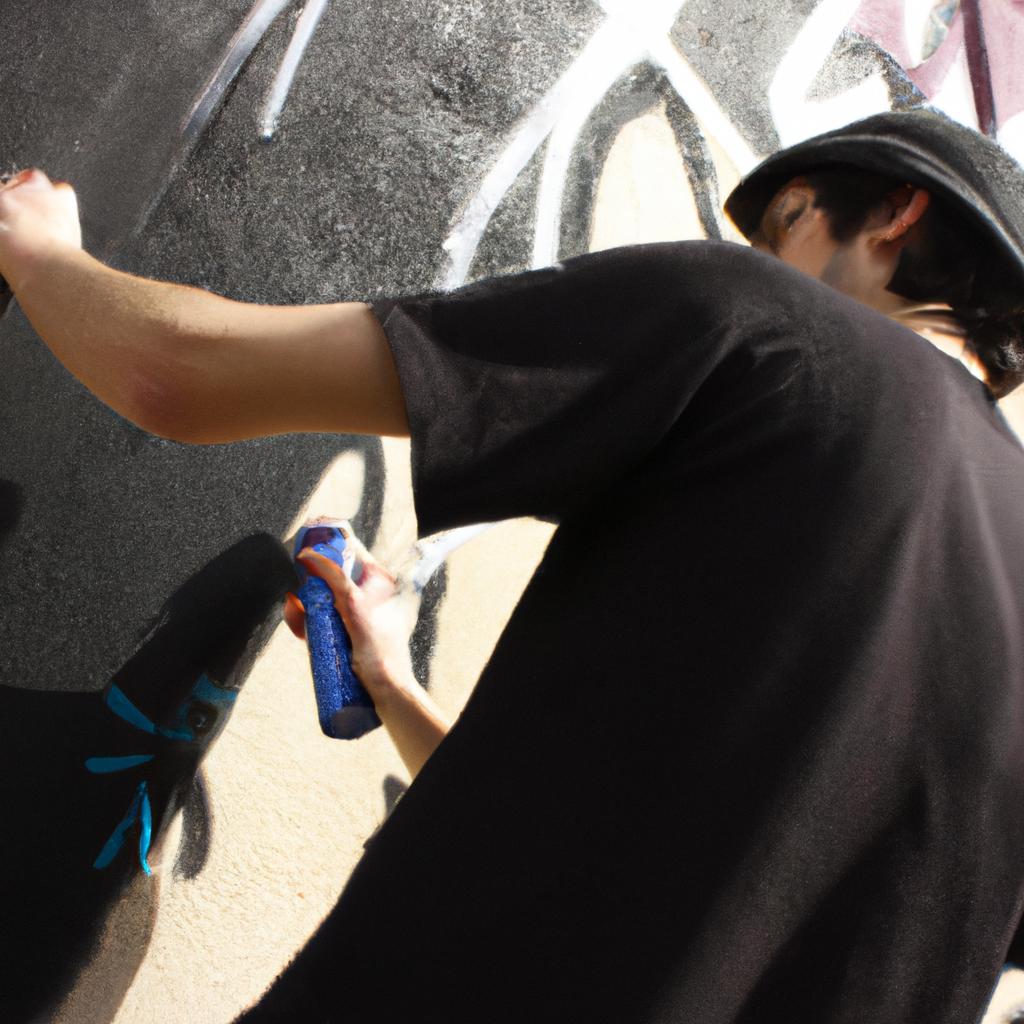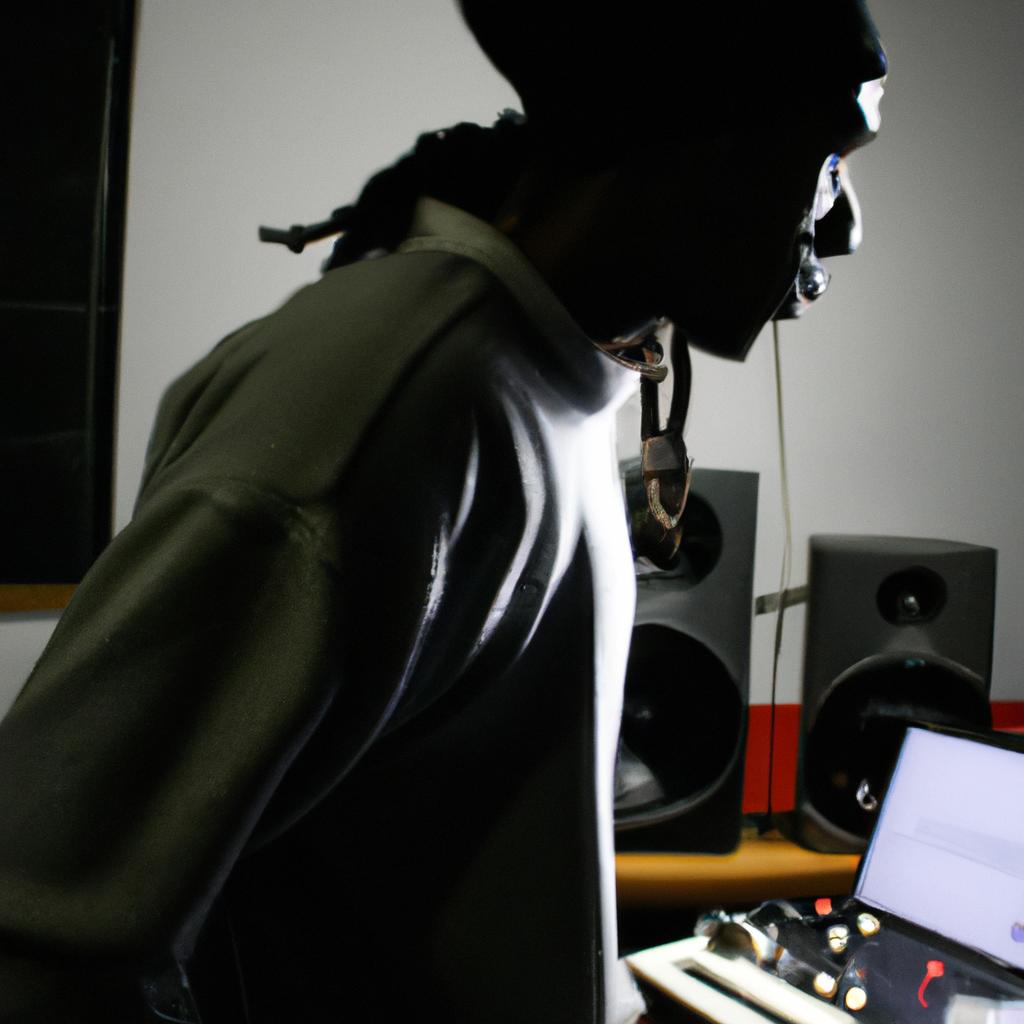Graffiti and street art have long been intertwined with the cultural movement of hip hop, serving as powerful visual expressions that reflect the social and political contexts in which they emerge. These artistic forms not only add vibrant aesthetics to urban landscapes but also serve as platforms for marginalized voices seeking to challenge societal norms. For instance, consider a hypothetical scenario where an anonymous graffiti artist creates a thought-provoking mural on a dilapidated wall in a low-income neighborhood. Through this act of rebellion against neglect and marginalization, the artist sparks conversations about inequality and gentrification, highlighting the crucial role of graffiti and street art within hip hop culture.
The origins of graffiti can be traced back to ancient civilizations, where individuals used markings on walls to communicate messages or leave their mark. However, it was during the late 1960s and early 1970s in New York City that graffiti became intrinsically linked with hip hop culture. Emerging from socio-economic struggles faced by African American and Latinx communities, hip hop provided an outlet for self-expression through various artistic mediums, including rap music, breakdancing, DJing, and graffiti. Graffiti writers saw abandoned buildings and subway trains as blank canvases waiting to be transformed into vibrant works of art that would capture the energy and spirit of the marginalized communities they belonged to. These artists used spray paint, markers, and other mediums to create intricate and visually striking murals that became synonymous with hip hop culture.
Graffiti served as a form of rebellion against the neglect and decay present in many urban environments. By reclaiming these spaces and transforming them into artistic expressions, graffiti writers challenged societal norms and brought attention to issues such as poverty, racism, police brutality, and gentrification. The vibrant colors and bold lettering of graffiti murals not only added aesthetic value to otherwise bleak landscapes but also acted as powerful visual statements that demanded recognition.
Furthermore, graffiti provided a platform for marginalized voices within hip hop culture. Often working anonymously or under pseudonyms, graffiti writers were able to express their opinions without fear of reprisal or censorship. Through their art, they could raise awareness about social injustices, highlight cultural heritage, celebrate community resilience, and convey messages of empowerment.
While graffiti has faced varying degrees of acceptance throughout history due to its association with vandalism and illegal activities, it remains an integral part of hip hop culture. Many cities around the world have recognized the value of street art in revitalizing neighborhoods and promoting creative expression. Street art festivals and legal mural projects now provide platforms for artists to showcase their talents while beautifying public spaces.
In conclusion, graffiti and street art have played a significant role within hip hop culture by providing visual expressions that reflect social and political contexts. These artistic forms serve as platforms for marginalized voices seeking to challenge societal norms while adding vibrancy to urban landscapes. Through acts of rebellion against neglect and marginalization, graffiti artists spark conversations about inequality and gentrification, highlighting the crucial role of street art within hip hop culture.
Historical roots of graffiti and street art
Historical Roots of Graffiti and Street Art
Graffiti and street art have a rich history deeply rooted in urban culture. To understand their origins, it is important to explore the historical context within which these forms of expression emerged. One compelling example that highlights this connection can be seen in the case study of New York City during the 1970s.
During this time period, neighborhoods throughout New York City faced economic decline, social unrest, and widespread dissatisfaction among marginalized communities. In response to these challenges, artists from various backgrounds began using public spaces as a canvas for their creative expressions. Through vibrant colors and bold lettering, they turned abandoned buildings and subway trains into visual manifestations of their cultural identities. This act of reclaiming neglected spaces not only provided an outlet for artistic self-expression but also served as a form of protest against social inequalities.
The emergence of graffiti and street art was not confined solely to New York City; similar movements also appeared in other urban areas around the world. These artistic practices were often associated with hip hop culture, representing its rebellious spirit and commitment to challenging conventional norms. To further illustrate this point, consider the following bullet points:
- Self-Expression: Graffiti allowed individuals who felt unheard or oppressed to express themselves authentically.
- Community Building: The creation of murals and tags fostered a sense of belonging within local communities.
- Artistic Exploration: Artists experimented with different styles and techniques, pushing boundaries within the medium itself.
- Political Commentary: Some works contained powerful messages critiquing societal issues such as racism or poverty.
To better visualize the impact of graffiti on urban landscapes worldwide, we can look at the following table:
| City | Year | Description |
|---|---|---|
| New York | 1970 | Subway train artwork |
| Paris | 1984 | Mural celebrating diversity |
| São Paulo | 1990 | Street art as social critique |
| Berlin | 2003 | Expression of reunification |
The historical roots of graffiti and street art lay the foundation for their subsequent evolution as forms of expression. By examining this evolution, we can gain a deeper understanding of the dynamic nature of graffiti and street art in hip hop culture.
[Transition Sentence]
Moving beyond its origins, the transformation of graffiti as a form of expression has been shaped by various factors that reflect both societal changes and individual artists’ creative journeys.
Evolution of graffiti as a form of expression
Transition: Building upon the historical roots of graffiti and street art, it becomes evident that these forms of expression have undergone significant evolution over time. This section explores how graffiti has transformed from mere acts of rebellion into complex artistic movements within hip hop culture.
Section: Evolution of graffiti as a form of expression
Graffiti’s journey as an art form can be best understood through its evolving techniques, themes, and cultural significance. To illustrate this progression, let us consider a hypothetical case study focused on a renowned street artist named Alex. Beginning their career in the early 2000s, Alex started by creating simple tags on walls around their neighborhood, driven by personal expression and a desire to leave their mark. Over time, they honed their skills and began experimenting with more intricate lettering styles influenced by calligraphy and typography.
As the movement evolved further, several key developments emerged:
- Introduction of stenciling: Artists like Banksy popularized the use of stencils for creating detailed images quickly and anonymously.
- Shift towards murals: Street artists started using larger spaces such as building facades or entire walls as canvases to create impactful murals that conveyed powerful messages.
- Incorporation of mixed media: Graffiti expanded beyond spray paint alone, incorporating elements like wheat-pasting (gluing printed images onto surfaces) or installations to enhance visual impact.
- Exploration of social issues: Increasingly, street artists used their work to shed light on societal problems such as inequality, racism, environmental concerns – transforming graffiti into a platform for social commentary.
To further demonstrate the breadth and diversity within contemporary graffiti culture, we present a table showcasing four notable street artists along with some defining characteristics of their work:
| Artist | Style | Themes |
|---|---|---|
| Banksy | Stencil-based | Political satire |
| Swoon | Wheat-pasting | Human connection |
| Os Gemeos | Mural-based | Brazilian culture and folklore |
| Shepard Fairey | Mixed media | Activism |
This evolution of graffiti within hip hop culture has not only transformed the artistic landscape but also created a platform for social and political activism. By utilizing public spaces, street artists are able to reach a wider audience than traditional gallery settings, facilitating discussions on pressing issues that might otherwise remain overlooked or ignored.
Transition: Street art’s ability to spark conversations and challenge societal norms paves the way for our next section, which delves into how it serves as a powerful tool for social and political activism without explicitly stating “step”.
Street art as a platform for social and political activism
Having explored the evolution of graffiti as a form of expression, we now delve into the realm of street art and its significant role as a platform for social and political activism. To illustrate this dynamic connection between art and activism, let us consider the example of Banksy’s iconic artwork titled “Girl with Balloon.”
Paragraph 1:
Banksy’s “Girl with Balloon” is an influential piece that showcases the power of street art to convey profound messages in public spaces. This renowned stencil work depicts a young girl reaching out towards a red heart-shaped balloon, symbolizing innocence and hope. The emotional impact of this image lies not only in its visual appeal but also in the underlying message it portrays. Through his thought-provoking creations like this one, Banksy aims to challenge societal norms and ignite conversations about pressing issues such as poverty, war, and consumerism.
To further understand the significance of street art as a platform for social and political activism, several key aspects come into play:
-
Accessibility: Unlike traditional forms of art confined within gallery walls, street art has the potential to reach diverse audiences who may not typically engage with artistic expressions. By existing in shared urban spaces accessible to all, these artworks become catalysts for dialogue among individuals from various backgrounds.
-
Subversion: Street artists often employ subversive techniques to disrupt established narratives or challenge dominant ideologies. Their provocative imagery serves as a means through which they can question authority, expose injustices, and advocate for marginalized voices.
-
Community engagement: Many street artists actively involve communities during their creative process by collaborating with local residents or incorporating elements specific to the neighborhood’s culture. This participatory approach fosters community empowerment while promoting inclusivity and shared ownership over public spaces.
Table (emotional response evoked):
| Words | Images | Emotions |
|---|---|---|
| Resistance | Fist raised | Empowerment |
| Solidarity | Unity symbol | Hope |
| Justice | Scales | Determination |
| Change | Butterfly | Transformation |
Paragraph 2:
The intersection of street art and activism is not limited to the visual impact it creates; it also extends to the transformative potential within urban landscapes. These artworks have the ability to breathe new life into neglected neighborhoods, transforming them into vibrant cultural hubs that attract visitors and inspire local pride.
By revitalizing dilapidated walls with colorful murals or thought-provoking installations, street artists contribute to the beautification of urban areas while simultaneously addressing social issues. Such interventions challenge conventional notions of public space, allowing communities to reclaim their environments and imagine alternative futures.
As we explore the impact of graffiti on urban landscapes, we witness how these artistic expressions shape our cities’ identities and provoke contemplation about societal values. Through this exploration, we gain deeper insights into the multifaceted nature of street art and its profound influence on both physical spaces and collective consciousness.
The impact of graffiti on urban landscapes
Having examined street art as a platform for social and political activism, it is now crucial to delve into the impact that graffiti has on urban landscapes. To illustrate this point, let us consider an example where a dilapidated building in an impoverished neighborhood becomes transformed by vibrant graffiti murals. This transformation not only beautifies the area but also serves as a visual representation of hope and resilience within the community.
One must acknowledge that the impact of graffiti on urban landscapes extends beyond mere aesthetics. It brings about several significant effects that shape both physical spaces and societal perceptions. First and foremost, graffiti creates a sense of place identity by giving neighborhoods their own unique character. These colorful artworks serve as emblems of cultural diversity, encapsulating the histories and stories of the communities they inhabit.
Furthermore, graffiti challenges traditional notions of ownership and control over public spaces. By reclaiming walls and surfaces with artistic expressions, artists empower themselves and local residents to take agency over their surroundings. This form of self-expression fosters a sense of belonging among individuals who may otherwise feel marginalized or overlooked.
To fully grasp the impact of graffiti on urban landscapes, one must understand its ability to evoke emotions in passersby. Here is a bullet-point list highlighting some emotional responses often elicited:
- Awe at the creativity displayed in these unconventional art forms.
- Surprise at unexpected encounters with thought-provoking images.
- Wonderment at how something once considered vandalism can transform into compelling works of art.
- Appreciation for artists’ dedication to making cities more visually captivating.
In addition to evoking emotions through imagery alone, we can further explore this impact using a table showcasing different perspectives towards graffiti:
| Perspective | Response |
|---|---|
| Local Residents | Pride in community identity |
| Municipalities | Concerns over property damage |
| Tourists | Fascination with urban subcultures |
| Other Artists | Inspiration for their own creations |
In conclusion, graffiti’s impact on urban landscapes goes beyond its visual appeal. It shapes place identity, challenges notions of control over public spaces, and evokes a range of emotions in those who encounter it. As we move forward, we will delve into the controversies surrounding graffiti and street art while keeping these impacts in mind.
With an understanding of the transformative influence graffiti has on urban landscapes, it is essential to now explore the controversies that surround this art form.
Controversies surrounding graffiti and street art
Having explored the profound impact of graffiti on urban landscapes, it is now crucial to delve into the controversies that often surround this form of artistic expression. By examining various perspectives, we can gain a deeper understanding of the complex relationship between graffiti, street art, and society.
Controversies Surrounding Graffiti and Street Art:
One notable controversy revolves around the legality of graffiti. While some argue that unauthorized public artwork should be considered vandalism with severe consequences, others contend that these acts are essential for marginalized communities as they provide an outlet for self-expression. For instance, imagine a rundown neighborhood where neglected buildings become canvases for local artists who transform them into vibrant murals depicting their cultural heritage or political struggles. Such instances highlight how illegal graffiti can breathe life into forgotten spaces and ignite conversations about social issues.
Furthermore, conflicts arise regarding ownership and control over public spaces. Critics argue that uncommissioned artworks infringe upon private property rights and disrupt visual harmony within cities. On the other hand, supporters emphasize the democratic nature of street art, arguing that it democratizes access to culture by reclaiming public spaces for everyone’s enjoyment rather than solely catering to privileged individuals or institutions. This tension underscores the broader debate about whose voices are represented in our shared environments.
- Loss of cultural heritage due to gentrification
- Suppression of alternative narratives through censorship
- Alienation felt by disadvantaged communities lacking creative outlets
- Transformation of urban decay into visually stimulating cityscapes
In addition to these debates and tensions, there exists a range of attitudes towards graffiti among different demographics. Some perceive it purely as destructive behavior indicative of social disorder, while others see it as a form of rebellious art that challenges societal norms. To illustrate this diversity of views, consider the following three-column table:
| Perspective | Description | Emotion Evoked |
|---|---|---|
| Law enforcement | Views graffiti as illegal and detrimental to public spaces | Frustration |
| Local community | Appreciates graffiti for its cultural expression and neighborhood pride | Empowerment |
| Urban development authorities | Sees graffiti as an obstacle to urban revitalization efforts | Concern |
In conclusion, controversies surrounding graffiti and street art are inevitable due to their inherent nature as creative expressions existing outside traditional artistic institutions. The clash between legality, ownership, and differing perspectives highlights the multifaceted relationship society has with these forms of artistic engagement. Understanding these debates is crucial in comprehending the role that graffiti and street art play in shaping hip hop culture.
Transition into the subsequent section about “The role of graffiti and street art in shaping hip hop culture”:
By examining the controversies surrounding graffiti and street art, we can now explore how these expressive mediums have contributed significantly to shaping the vibrant landscape of hip hop culture.
The role of graffiti and street art in shaping hip hop culture
Controversies surrounding graffiti and street art have long been a topic of debate within the realm of hip hop culture. While some view these forms of artistic expression as vibrant manifestations of creativity, others perceive them as acts of vandalism that contribute to urban decay. In examining the context in which graffiti and street art exist, it is important to consider both perspectives and explore their implications.
To illustrate this point, let us consider a hypothetical case study involving a community mural project in an urban neighborhood. A group of local artists collaborates with residents to create a large-scale artwork on the side of a building, transforming what was once a plain wall into a visually captivating masterpiece. Supporters argue that projects like these not only beautify neglected spaces but also foster community engagement and pride. Conversely, opponents may argue that such endeavors perpetuate unauthorized use of public property and encourage more illegal graffiti.
In order to gain a deeper understanding of the controversies surrounding graffiti and street art in relation to hip hop culture, several key factors should be taken into account:
- Legal frameworks: The legality or illegality of graffiti differs from one jurisdiction to another, leading to varying attitudes towards its presence in communities.
- Cultural significance: For many individuals involved in hip hop culture, graffiti and street art represent an authentic form of self-expression deeply rooted in the historical struggles faced by marginalized communities.
- Property rights: Critics often stress the importance of respecting private property rights when discussing instances where graffiti appears without consent on buildings or other structures.
- Economic impact: Some argue that certain types of street art can boost tourism and generate revenue for businesses located in areas known for their vibrant murals.
To further comprehend the multifaceted nature of this subject matter, we can examine different viewpoints through the following table:
| Perspective | Argument |
|---|---|
| Artistic | Graffiti and street art are valid forms of artistic expression that bring vibrancy to urban spaces. |
| Legal | Unauthorized graffiti should be considered vandalism and subject to legal consequences. |
| Cultural | Graffiti and street art are integral components of hip hop culture, reflecting its history and struggles. |
| Property owners | Graffiti is a violation of property rights and diminishes the aesthetic appeal of neighborhoods. |
In considering these diverse perspectives, it becomes evident that discussions surrounding graffiti and street art in hip hop culture are complex and multifaceted. While acknowledging the potential controversies they entail, it is essential to engage with this topic through an open-minded lens that recognizes both artistic merit and respect for public and private spaces.
Overall, understanding the role of graffiti and street art within the context of hip hop culture requires careful consideration of various viewpoints, legal frameworks, cultural significance, property rights concerns, as well as potential economic impacts. By examining these factors systematically, we can gain a more comprehensive understanding of how these forms of artistic expression contribute to shaping contemporary urban environments while also appreciating the underlying debates that surround them.




